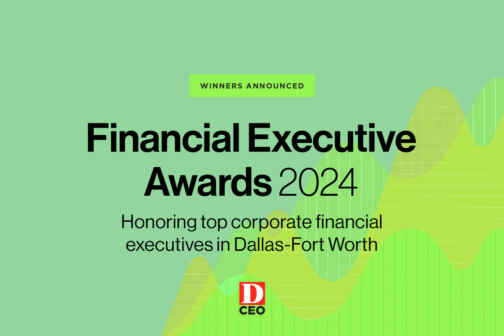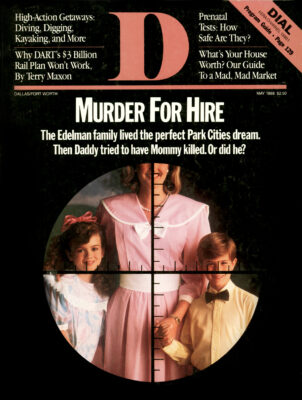At times (luring the past several months, I have felt as if I had stepped into television’s eerie “Twilight Zone. ” I felt that way the morning I visited the office of Charles Anderson, director of DART. I had come to talk to Anderson about our article on rail (see “The 3 Billion Dollar Boondoggle, ” page 58), in which former Dallas Morning News transportation writer Terry Maxon argues that the rail system DART proposes to build is a costly mistake. But Anderson had other, more pressing concerns. Like how to appease an anxious consortium of West End merchants who fear that construction of a Pacific Avenue subway will be bad for business. And how to foster the transit agency’s goals of joint development with large landowners like Southland-without appearing to bargain for that support with the public trust.
I settled myself onto the couch, aware that my question-Should we really be building this thing?-would seem absurdly foreign to a debate already advanced to the fine points of drilling through limestone. Anderson proudly paraded a large artist’s rendering of a rail car. It was the car that DART has approved for purchase, assuming that the voters grant the agency license to sell long-term bonds in the referendum next month. It is a seductive image-sleek yet wide, trimmed in DART’s signature yellow, shiny, new, with large picture windows. It’s a far cry from the subway trains that I frequented during ten years of living in New York.
Perhaps the image of that rail car is especially alluring to me and others of my generation whose wandering impulses were shaped by the footloose Sixties and endowed by the post-war prosperity of our parents. Many of us have experienced the world’s great cities first-hand. And the world’s great cities have trains.
I had come to Anderson’s office because for me, that hypnotic notion (all great cities have rail, therefore Dallas must have it too) had been coldly doused by reality, which left me full of foreboding.
As always, Anderson was cordial, candid, and adamant in his belief that a rail plan for the Dallas area will work (see “The Man In The Hot Seat, ” page 62). He dismissed the arguments of skeptics, replacing them with the assurances of his own projections. It would not be long before a report authored by a joint committee of the Dallas Citizens Council and the Greater Dallas Chamber of Commerce-formed to mollify other public doubters-would bless those assurances with the sanction of the business community.
But not without acrimony and not without reservation. The report of the committee, which was chaired by attorney Thomas W. Luce (best known as Ross Perot’s frequent point man), encourages a “yes” vote on the referendum enabling DART to incur long-term debt in order to meet short-term cash needs. It gives a green light to the aggressive securing of needed right-of-way while actively pursuing federal funding. But the report also chastises DART for “gold-plating, ” committing lavish sums to incidentals such as a new board room. It charges DART to reduce its size to contain administrative costs and urges the i agency to explore more thoroughly transportation, options other than rail. And the joint committee vows j to take the role of “vigilant watchdog, ” monitoring; DART’s progress and standing ready to “blow the whistle” if the agency’s fiscal controls begin to derail.
A key concern outlined in the Luce panel report is the fate of DART itself. “The greatest risk of rejecting the referendum is that it will lead to the dissolution of DART, ” the report warns. The committee’s fear is a valid one: if the suburbs are staying with DART only because of a belief that the payoff for their one-cent sales tax is rail, then it is reasonable to assume that they will opt out if long-term funding is rejected. We do need a unified regional approach to our transportation problems, therefore we need a strong DART.
But it is useful to remind ourselves that DART is not a synonym for rail. If voters decide to delay the rail portion of the plan, opting instead for a “pay as you go” process (which is what we were promised in 1983), some deft political footwork will be in order.
Still, I can’t shake the core argument that was a turning point for me on this issue. And that is that urban planning academics-transportation experts without local biases, interests, or idealism-have been saying for a decade that high-cost rail systems are obsolete, and worse, destined to become fiscal albatrosses to the communities they were built to serve.
These arguments are detailed in Maxon’s article. You can read them, weigh them, and make up your own minds.
There is another aspect of the issue that warrants mentioning. And that is how we as a community have handled this debate.
Seldom has an issue provoked a more bitter division among old allies-businesspeople primarily, who have united behind communal causes for decades. Those who challenged the rail plan have been made to feel disloyal to Dallas, traitors to progress. What might have been gentlemanly disagreements deteriorated into whispered personal attacks. The motives of advocates on both sides of the debate were called into question. In the end, the lone dissenter on the seven-man Luce panel drafted a letter outlining his opposition. He was told that the letter would be circulated as part of the report. It wasn’t. We still believe that open conflict is to be avoided at all costs.
We must learn to become more comfortable with conflict. If we’re not going to disagree on the largest public improvement expenditure in the city’s history, what are we going to disagree on? There is no shame in an honest airing of opposing viewpoints. Surely a benchmark on the road to becoming a city that is truly “world-class” is the ability to tolerate-even encourage-public debate.
Whether another milestone will be reached through the promise of shiny new trains is up to the voters in June’s DART referendum. Personally, I can think of more uplifting ways to spend $3 billion.
Related Articles

Dallas 500
Meet the Dallas 500: Mike Tomon, Co-President and COO of Legends Hospitality
The exec talks about Legends' long term partnership with Real Madrid, his leadership strategies, and the pet alligator he had in college.
By Ben Swanger

D CEO Award Programs
Winners Announced: D CEO’s Financial Executive Awards 2024
Honorees in this year’s program include leaders from o9 Solutions, Baylor Scott & White, and Texas Capital, as well as our Constantine ‘Connie’ Konstans Award winner Mahesh Shetty of ILE Homes.



